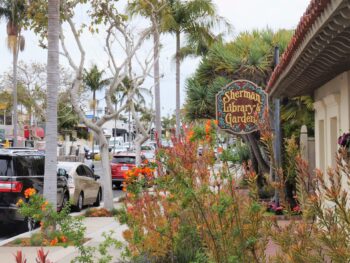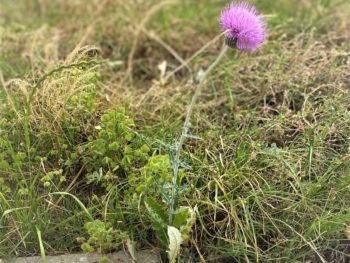Gardeners, don’t you love the way our crazy passion seems to crop up everywhere we go? I had two weekends of travel this spring, in what I thought would be time away from our growing Bible garden…surprise! With a little digging, I discovered our anniversary trip to New York and my visit with family and friends in the Pacific Northwest brought me right back to Bible plant treasures—one of the biggest, I might add.
From coast to coast, cedars of Lebanon have been planted in the United States for the public to enjoy. Though our country itself is not nearly as old as the lifespan of this species, Cedrus libani, member of the Pinaceae or pine family, these spectacular trees are worth the extra time to seek them even in their relatively “sapling” state. Cedars live for over a thousand years, though the cedars planted in Central Park are likely just a few decades old, and those at Hoyt Arboretum have thrived for 85 years.
Since they grow to over 100 feet tall with trunk girths of 10 feet or more, these true-cedar species are probably too magnificent for the home garden; even more wonderful that our park planners and donors had the foresight to plant them for generations to see for themselves.
He told them this parable: “Look at the fig tree and all the trees. When they sprout leaves, you can see for yourselves and know that summer is near. Even so, when you see these things happening, you know that the kingdom of God is near.
Luke 21:29-31
East Coast: Central Park

Evergreens were an original favorite of 1858 Central Park architects Frederick Law Olmstead and Calvert Vaux, who intended a “Winter Drive” of pines from 72nd to 102nd Streets along the west side of the park. Their original vision was refreshed with the contributions of Arthur Ross and the establishment of the Pinetum, a pine tree collection including 17 species, in the 1970s. Evergreens in the park have become important to bird-watchers, providing winter shelter for the park’s feathered friends.

So [cedar of Lebanon] towered higher than all the trees of the field; its boughs increased and its branches grew long, spreading because of abundant waters. All the birds of the sky nested in its boughs…
Ezekiel 31:5-6 NIV
Several cedar of Lebanon are located in a small grove on the east side at 72nd Street, just north behind the information kiosk. These are accompanied by a small plaque dedicating the grove for grandchildren by patrons Linda and Mort Janklow, embodying the sense of faithful legacy that these long-lived trees inspire.

The righteous …will grow like a cedar of Lebanon; planted in the house of the Lord, they will flourish in the courts of our God. They will still bear fruit in old age, they will stay fresh and green, proclaiming, “The Lord is upright; he is my Rock, and there is no wickedness in him.”
Psalm 92:12-15 NIV
link to locate cedar of Lebanon in Central Park
West Coast: Hoyt Arboretum

It seems only fitting to find cedar of Lebanon at the Hoyt Arboretum in Portland, Oregon. This prominent planting of trees suits the Pacific Northwest in every way, a cool series of glens with wooded, sheltered paths perfect for gentle walks or fast-paced hikes. Original visionaries establishing this public refuge in the early 1900’s include John Charles Olmstead, Frederick Law Olmstead’s step-son (nephew?), and county commissioner Ralph Warren Hoyt, for whom the arboretum is named. John W. Duncan, a foremost plantsmen and horticulturalist took the helm in 1930; Duncan’s knowledge seemed to have resounded King Solomon’s!

He spoke about plant life, from the cedar of Lebanon to the hyssop that grows out of walls.
1 Kings 4:33 NIV
Duncan oversaw a large planting in 1931 now called the Duncan Plan. The cedar of Lebanon grove along SW Bray Road was installed at this time.
From Hoyt Arboretum History:
Duncan was heavily influenced by the tradition established by Frederick Law Olmsted in his plan for America’s premier arboretum, Harvard’s Arnold Arboretum in Boston. The Arboretum’s landscape is planned to create both a sense of unity and mystery, alternating open meadows and groves of trees, all appearing relatively natural. At the same time, because of the Arboretum’s educational and scientific purposes, the trees throughout the Arboretum are presented in taxonomically organized groups, surrounded by other members of their same genus, family, and order.
link to to locate cedar of Lebanon at the Hoyt Arboretum

Walk with the Cedars of Lebanon

Longtime supporters of God’s Word for Gardeners Bible gathered with me last month to see the cedars for ourselves. Between cool, refreshing rain showers, we walked along the arboretum trees to spy the cedar, their color, needle style, and habit setting them apart from surrounding conifers. Though many on our outing have spent a lifetime enjoying the park, they were excited to discover the trees all over again— were all glad to be together, praise our God, and take delight in what He speaks to us through these mighty trees.
The trees of the Lord are well watered, the cedars of Lebanon that he planted.
Psalm 104:16 NIV
Watch for more events from Garden in Delight like this one, exploring homegrown plantings from the Holy Land.
A-to-Z Primer of Plants from God’s Word
In my excitement, dear friends, I forgot to read the latest installment of A-to-Z Primer of Plants from God’s Word, written for this special day.
is for cedar
but not just any one;
we are sing-songing here
for the cedar of Lebanon.
Splendid in beauty
like no other tree,
the cedar of Lebanon
displays God’s majesty.
It towers on high,
its branches grow long.
The jubilant forest seems
to burst into song!
Great and marvelous are your deeds,
Almighty Lord God;
King of the nations,
before you, we applaud.
Your reign revealed forever—
in cedar’s boughs we see
branches airy and extended,
spreading horizontally.
What does it mean for the
righteous to grow like one?
To become mighty in faith
and shelter others in the Son.
When the glory of Lebanon
adorns God’s sanctuary,
then you will know
your Redeemer—be merry!
Deck the halls! Praise His Greatness!
Sing joyful fa-la-la’s!
His everlasting Kingdom
will come to all of us.



Read more devotions on cedar of Lebanon in Garden Tour section of God’s Word for Gardeners Bible, beginning on page a-17

Find further photography and information, including a link to all Garden in Delight cedar of Lebanon blogs, in our Plant Guide – www.gardenindelight.com/plant-guide/cedar-lebanon/
Photo Credits:
©2016 Shelley S. Cramm from top to bottom:
Detail of cedar of Lebanon needles. True cedars (of the Cedrus genus) grow needles in tufts; for the cedar of Lebanon, these are usually upward facing.
A Central Park cedar, just north of 72nd Street east, with a skyscraper towering in the background. The cedar trunk splits from its central base as the tree ages.
Cedar branches in Hoyt Arboretum, with a solitary cone in view. Needle “tufts” are bright green with spring growth.
It’s a tree party! Longtime supporters of God’s Word for Gardeners Bible enjoy a walk with the cedars: Karen Zaha, Charlotte & Jim Macfee (my parents!) Bob & Connie Russell, Susan Fuller, Marge Roberts, Mike Zaha, Marlene Hope.
C is for cedar of Lebanon, a drop cap sketch.
NIV denotes Scripture quotations taken from the Holy Bible, New International Version®, NIV®. Copyright © 1973, 1978, 1984, 2011 by Biblica, Inc.® Used by permission of Zondervan. All rights reserved worldwide. www.zondervan.com The “NIV” and “New International Version” are trademarks registered in the United States Patent and Trademark Office by Biblica, Inc.®














